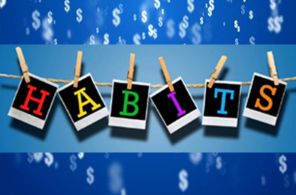Habits are a part of life. Sometimes they creep up on us and sometimes we have to work hard to achieve them. For  example, we don’t think about the fact that we might stop for coffee on our way to work every morning, but we certainly know how difficult it is to eat clean or exercise on a daily basis. Some habits are free and the benefits are priceless, but others are costly, not only to our wallets, but also to our health, our emotions and our relationships. This lesson has students looking at the true cost of the habits that might be part of their lives now or in the future. Hopefully, this activity will help them to really think about the consequences associated with habits before they decide to continue them or help them form healthier ones.
example, we don’t think about the fact that we might stop for coffee on our way to work every morning, but we certainly know how difficult it is to eat clean or exercise on a daily basis. Some habits are free and the benefits are priceless, but others are costly, not only to our wallets, but also to our health, our emotions and our relationships. This lesson has students looking at the true cost of the habits that might be part of their lives now or in the future. Hopefully, this activity will help them to really think about the consequences associated with habits before they decide to continue them or help them form healthier ones.
Set
- View a clip of about a woman whose habit was to buy a daily Starbucks from YouTube found here.
- Listen to her story and then brainstorm a list of habits you, your family, friends of yours or people you know participate in on a regular basis. These can be positive or negative. List may include, but not be limited to the following: coffee, smoking, chew, ice cream, breakfast at the local diner, fast food, soda, vending machine snacks, indoor tanning, lottery tickets, sports betting/wagers, a beer after work, exercise, video games, etc.
Materials
- Laptops
- Calculators
- Poster Supplies
Activities
- Describe how habits can be costly. Try to get students to think beyond just the monetary costs associated with habits. Yes, habits can be costly to our wallets, but also to our physical health, our emotional well-being or state of mind, as well as affect our social relationships. Sometimes the costs are positive and sometimes they are negative.
- Do an example together…There’s an elderly lady that visits a seasonal ice cream parlor every day from May 1 until September 30. Each day she orders a large dish of ice cream which costs her $3.73. Let’s take a look at the costs associated with this habit. Financially: $3.73/day, $26.11/week, $104.44/month, approx. $571/total time Physically: Could contribute to weight gain, heart disease, or diabetes Emotionally: Feels happy when she eats ice cream, less lonely Socially: Gets her out of the house, and she gets to visit with others at the parlor
- Individually or in pairs (depends on class size), randomly assign students a habit topics found in lesson plan below) to investigate the costs associated with it. There is a calculator link on the Spendster website that may be helpful for students to cost their habit. They are to create a visual representing their habit and its costs and then share it with the class. Their visual can be a poster, PPT slide, Canva, or Prezi. The visual must include:
- Title of the Habit
- The Costs Specifically Identified (Financial, Physical, Emotional, Social & Other)
- Cost Areas Labeled as Positive or Negative
- Pictures/Graphics of Habit
- After students present habit costs, ask students if their presented habit is worth the costs in their opinion and why. When all of the habits are presented as students to write a summary explaining what the title “The True Cost of a Habit” really means.
- Extension Assignment or Extra Credit: Create a video like those on the spendster website describing a habit that you have. Submit it for consideration on their website.
Attachments
Resources

